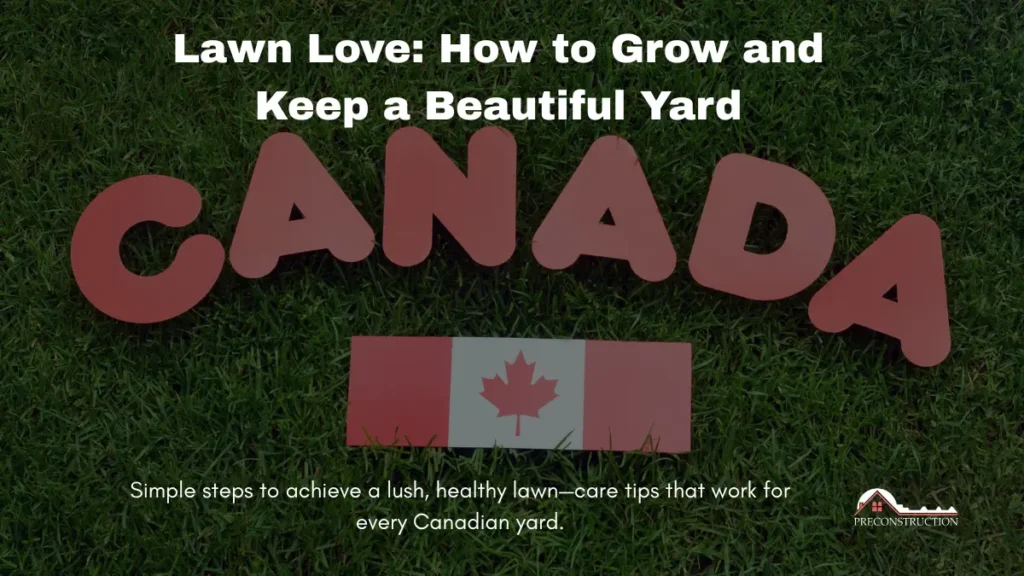A vibrant, green lawn is more than a stretch of grass—it’s a peaceful retreat, a gathering space, and a symbol of pride for many homeowners across Canada. From kids’ playtime to backyard parties or simply lounging on a summer afternoon, your lawn sets the stage for life’s outdoor moments. But achieving and maintaining a beautiful yard requires more than occasional mowing and watering. It demands seasonal care, regional knowledge, and a smart, strategic approach to maintenance.
In this comprehensive guide, we’ll walk you through every stage of lawn care in Canada—from soil preparation and seeding to advanced maintenance tips. Whether you’re working with a brand-new plot or trying to restore an existing yard, these tips will help you grow a thick, healthy, and resilient lawn that thrives through all seasons.
1. Why Lawn Health Matters
A healthy lawn offers several benefits beyond beauty:
Environmental: Lawns act as natural air filters, trapping dust and pollutants. They help reduce soil erosion and cool your surroundings through evapotranspiration.
Economic: A lush yard can increase curb appeal and even your home’s resale value.
Functional: Lawns provide space for recreation, relaxation, and gardening activities.
However, the path to a vibrant yard starts with preparation—and it all begins beneath the surface.
2. Soil Is Everything: Build the Right Foundation
Your grass is only as healthy as the soil it grows in. Canadian soil varies dramatically from one province to another—some areas have sandy, well-drained soil; others deal with heavy clay or rocky terrain.
Step 1: Test Your Soil
Start by testing your soil’s pH and nutrient content. Soil test kits are inexpensive and easy to use. Ideal pH for most grasses is between 6.0 and 7.0. If your lawn’s pH is off, consider:
Adding lime for acidic soil.
Adding sulfur for alkaline soil.
Step 2: Aerate for Oxygen and Drainage
Aeration is especially important in compacted or heavily trafficked areas. Aerating involves perforating the soil with small holes to allow air, water, and nutrients to penetrate deeper. Do this:
In spring or fall
Every 1–2 years, or more often if your soil is clay-heavy
Core aerators (which pull out plugs of soil) are more effective than spike aerators, which just poke holes.
Step 3: Topdressing and Composting
After aerating, consider applying a thin layer of compost to help improve organic matter in your soil. This boosts microbial life and improves water retention.
3. Choose the Right Grass Type
Canada’s climate ranges from temperate on the west coast to frigid in the north, so the grass you choose must match your zone.
Cool-Season Grasses (Best for Most of Canada):
Kentucky Bluegrass: Lush and green, ideal for full sun.
Fescues (fine or tall): Great for shade and low maintenance.
Perennial Ryegrass: Fast germination, often used in seed blends.
Warm-Season Grasses:
Rare in Canada, but in some southern parts of Ontario or BC, Zoysia or Bermudagrass may survive with proper care.
Always choose a region-specific blend for durability, disease resistance, and optimal performance.
4. Seed or Sod? Starting Your Lawn
Seeding
Pros:
Cost-effective
Variety of grass options
Cons:
Requires patience and frequent watering
Steps:
Rake and level the soil
Distribute seed evenly
Lightly cover with topsoil
Water daily until germination (2–3 weeks)
Sod
Pros:
Instant lawn
Erosion control
Cons:
Expensive
Limited to what’s available
When laying sod, roll it out like a carpet, staggering joints like bricks. Press seams together tightly to avoid drying gaps.
5. Smart Watering: Less Often, More Deeply
Lawn watering in Canada must be efficient, especially with seasonal water restrictions. The golden rule:
Water deeply, not frequently
Aim for 1 inch of water per week, including rainfall. In dry months, water every 4–5 days, early in the morning to reduce evaporation.
Signs of Underwatering:
Footprints remain visible after walking
Grass appears dull, greyish-blue
Leaf blades curl
Invest in rain gauges, moisture meters, or even smart irrigation systems to prevent overwatering and detect dry zones.
6. Fertilization: Feeding for Strength
Fertilizer helps grass grow thicker and greener, but it must be timed and applied correctly.
Types of Fertilizers:
Slow-release granular: Steady feeding over time
Liquid: Fast results, but shorter duration
Organic: Compost, bone meal, or seaweed-based
Fertilizing Schedule in Canada:
Spring: Nitrogen-rich to stimulate growth
Summer: Lighter feeding, especially during droughts
Fall: Potassium-heavy to prepare for winter dormancy
Always water after fertilizing to avoid burning your lawn.
7. Mowing Techniques That Matter
Mowing affects lawn health more than many homeowners realize.
Golden Mowing Rules:
Never remove more than one-third of the blade height
Cut when grass is dry
Keep blades sharp
Vary your mowing pattern weekly
The ideal cutting height is 2.5 to 3.5 inches, depending on grass type. Longer blades help shade soil, retain moisture, and outcompete weeds.
Avoid scalping the lawn—it weakens the root system and leaves your grass vulnerable to pests and heat.
8. Weed and Pest Control Without Harm
Every lawn faces its share of intruders—from dandelions to grubs.
Weeds
Hand-pulling is ideal for broadleaf weeds like dandelions or clover. For larger infestations:
Use a selective herbicide (not total vegetation killers)
Apply in early morning or evening, on a dry, calm day
Pests
Common pests in Canadian lawns:
Grubs: White beetle larvae that eat roots
Chinch bugs: Tiny insects that suck plant juices
Sod webworms: Larvae that chew grass blades
Natural remedies include nematodes, diatomaceous earth, and attracting birds or beneficial insects.
9. Tackling Common Lawn Problems
Brown Patches
Possible causes:
Drought stress
Pet urine
Fungus
Thatch buildup
Action:
Test the soil
Aerate and overseed
Adjust watering habits
Bare Spots
Reseed in early fall or spring
Use patch repair kits for faster results
Thatch
Thatch is a dense layer of organic material between the grass and soil. If it’s thicker than 0.5 inches:
Dethatch using a special rake or machine
Compost or mulch clippings to add nutrients back into the soil
10. Edging, Trimming, and Finishing Touches
Edges are where lawn meets landscape—walkways, driveways, garden beds. Keeping these clean improves both form and function.
Use a manual edger or power trimmer
Define lines around trees or shrubs
Add mulch borders for contrast and weed control
11. Seasonal Lawn Care Calendar in Canada
Spring
Rake debris
Aerate compacted areas
Fertilize and seed
Apply pre-emergent herbicide
Summer
Mow high
Water deeply and early
Spot treat weeds
Avoid fertilizing during heatwaves
Fall
Overseed and topdress
Fertilize with potassium
Aerate and rake leaves
Final mow before winter
Winter
Limit foot traffic
Avoid de-icers near lawn edges
Sharpen tools for spring
12. Tools and Equipment Every Homeowner Needs
Essentials:
Lawn mower (reel or gas)
Rake and dethatcher
Seed spreader
Garden hose with sprinkler
Aerator tool
Soil test kit
Optional upgrades:
Battery-powered trimmer
Rainwater collection barrel
Smart sprinkler controller
Edging shears
13. Sustainable and Eco-Friendly Lawn Practices
Want a green lawn with a green conscience?
Go native: Choose local grasses adapted to your climate
Compost clippings: Feed your lawn naturally
Install rain sensors: Prevent overwatering
Use organic fertilizers: Reduce runoff and pollution
14. When to Call a Professional
While many homeowners prefer a DIY approach, consider hiring a pro if:
You’re dealing with a full lawn renovation
There’s an insect or disease outbreak
You want custom irrigation or sod installation
Many companies offer seasonal lawn packages with environmentally friendly options.
Final Thoughts
A beautiful lawn doesn’t happen overnight—it’s built through consistency, seasonal care, and a willingness to adapt to your yard’s needs. By understanding your soil, selecting the right grass, watering wisely, and maintaining it all year round, you can create a lush landscape that’s not only pleasing to the eye but also functional and sustainable.
Whether you’re a first-time homeowner or a seasoned gardener, let your lawn reflect the care and love you put into your home. With the right knowledge and a little patience, your yard can be the green oasis you’ve always wanted.






